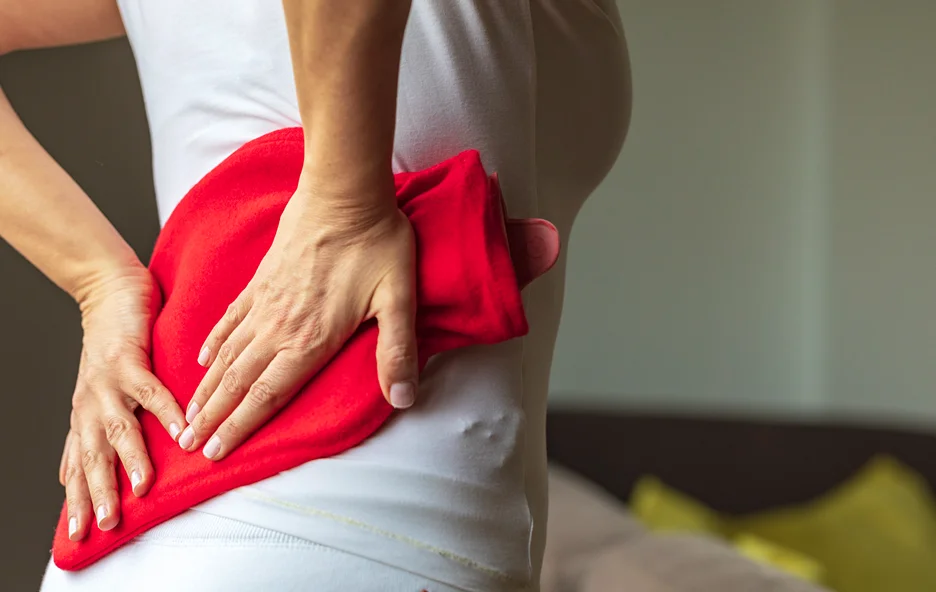So, you’ve got this nagging pain running down your leg and you’ve heard the term “sciatica” tossed around. Sounds fancy, right? Well, it’s basically a pain that traces the path of your sciatic nerve, going from your lower back, through your hips, down to each leg.
The silver lining? You don’t necessarily need to dash to a clinic to start feeling better. There’s a whole toolkit of home remedies, from specific stretches to heat applications, that might just do the trick.
A word of caution, though: if the pain hangs around longer than welcome or feels too intense, it might be a good shout to see a professional. But for now, why not give these home treatments a shot? After all, sometimes the simplest solutions are right under our noses.
What is Sciatica and How Does It Manifest?
Sciatica, at its core, is a condition characterized by pain, tingling sensations, or even weakness in the leg. This arises due to the sciatic nerve, the body’s most extensive nerve, becoming irritated or constricted.
Originating from the lower back, this nerve trails through the buttocks and concludes at the back of each leg. Several underlying conditions can trigger sciatica, including:
Herniated Disk
When we speak of a herniated disk, we’re referring to a scenario where the soft cushion (disk) that exists between the spine’s vertebrae either protrudes or ruptures. This misalignment can cause undue pressure on the sciatic nerve, often resulting in pain or discomfort that radiates through the leg.
Spinal Stenosis
Spinal stenosis describes a condition where the canal housing the spinal cord becomes narrower. As this canal constricts, it can press on the spinal cord itself and the surrounding nerves, potentially leading to symptoms similar to those of sciatica.
Degenerative Disk Disease
Over time, just as many things wear out, the disks in our spine can also deteriorate. Degenerative disk disease refers to this natural wear-and-tear process where these disks lose their cushioning ability, potentially irritating the sciatic nerve.
Spondylolisthesis
In the case of spondylolisthesis, one spinal vertebra shifts, sliding over the one directly below it. This displacement can exert pressure on the sciatic nerve, mirroring the symptoms of sciatica.
Additional Triggers
Beyond these cases, certain medical conditions, such as pregnancy, tumor growth, or specific infections, can also stir the waters of sciatica. Each brings its own set of challenges and may require specialized attention.
Symptoms Distinct to Sciatica
Sciatica primarily exhibits pain commencing in the lower back, and traveling down to the leg. This pain’s intensity can fluctuate, and its occurrence might be sporadic or persistent. Additional indicators encompass:
- A numbing or tingling sensation localized to the leg or foot.
- A perceivable muscle debility in the leg.
- Challenges in walking or maintaining an upright posture.
- Exacerbated pain during prolonged sitting or standing.
- A spike in discomfort while coughing or sneezing.
If these manifestations sound familiar, it’s pivotal to seek medical consultation to ensure accurate diagnosis and timely intervention.
Home Treatments: Their Efficacy and Advantages

Why Home Treatments Work
Home treatments for sciatica offer relief by targeting inflammation, enhancing flexibility, bolstering the spine-supporting muscles, and promoting good posture. Their hands-on approach allows for consistent and personalized care.
Economical and Handy Solutions
Opting for home treatments doesn’t just ensure relief; it also saves time and money. Without the continual need for clinic visits or prescribed medications, patients can manage their symptoms efficiently.
Heat and Cold: Your Therapeutic Allies
Ice Therapy
Ice packs are invaluable for their anti-inflammatory effects. For optimum results, wrap your ice pack in a towel and place it on the affected region. Short 20-minute sessions, repeated multiple times daily, can yield substantial relief.
Heat Therapy
On the flip side, heat pads soothe by relaxing tense muscles and facilitating better blood flow. Similarly, short applications of about 20 minutes, several times a day, can aid in alleviating discomfort.
The Power of Targeted Movement
Gentle Exercises: Stretch and Strengthen
Specific exercises, like the hamstring stretch or the lower back stretch, not only offer immediate relief but also foster spine health and flexibility. Always remember to initiate any new routine gradually, ceasing any activity that induces pain.
Low-Impact Exercises
Low-intensity exercises, such as water aerobics or stationary biking, are also beneficial. These activities bolster the muscles while ensuring the spine and nerves remain undisturbed.
Sleep Right, Sit Right: Posture’s Role
The Sleep Code
A proper sleeping position can be a game-changer. For back sleepers, a pillow under the knees can help, while side sleepers might find relief with a pillow tucked between their knees.
Sit and Stand Tall
Good posture isn’t just about appearances. When sitting, maintain a straight back and relaxed shoulders. While standing, avoid locking knees and keep the back straight, ensuring the spine remains in its natural alignment.
Over-the-counter Pain Solutions
OTC Medications: Quick and Accessible
Common over-the-counter medications, like ibuprofen or acetaminophen, can provide temporary relief from sciatic discomfort. However, it’s paramount to adhere to label directions and steer clear of exceeding the advised dose.
Self-Massage: A Personal Touch
Unlocking Muscle Tension
Self-massage can be the key to addressing tense muscles. Using tools like tennis or lacrosse balls, individuals can target specific muscles, especially the piriformis, for relief.
Embracing Natural Healing Methods
Baths and Epsom Salts
A warm bath infused with Epsom salts can work wonders, relaxing muscles and reducing inflammation. A 20-30 minute soak can rejuvenate the body and offer relief.
Herbs and Supplements
Natural supplements like turmeric and magnesium have been linked with nerve pain and inflammation alleviation. However, it’s essential to consult with healthcare professionals before integrating these into your regimen.
Building Daily Habits to Ward Off Sciatica Flare-Ups
Remember that a healthier body often equates to a healthier spine. By maintaining a balanced weight, the strain on your spine significantly reduces, thus lowering the risk of sciatica.
Move, Stretch, Repeat
Consistent exercise, especially low-impact ones like walking, swimming, or biking, can work wonders. These exercises fortify the muscles supporting your spine and improve flexibility, serving as a preventive measure against sciatica.
The Science of Standing and Sitting Right
Good posture is an unsung hero. When you stand or sit correctly, your spine aligns perfectly, distributing your weight uniformly. This balance minimizes the chances of those dreaded sciatica flare-ups.
The Right Way to Lift
When handling weighty objects, the technique is everything. Always ensure you’re bending your knees and engaging your legs, not just your back. This simple adjustment can safeguard you from unnecessary strain.
Footwear Matters
Selecting the right shoes is more than just a fashion choice. Steer clear of high heels and shoes lacking proper arch support to protect your spine.
The Role of Ergonomic Furnishings and Regular Breaks
In today’s digital age, many of us lead a sedentary lifestyle, making ergonomic furniture indispensable. Designed to mimic the body’s natural position, such furniture minimizes spinal stress, ensuring your posture remains optimal.
Some examples of ergonomic furniture include:
- Chairs with adjustable height, backrest, and armrests
- Desks with adjustable height
- Monitors at eye level
- Footrests
Little Breaks, Big Wins
If your job or routine binds you to a chair for extended periods, cultivate the habit of regular breaks. Aim to stand, stroll, or do gentle stretches every 20-30 minutes. This proactive approach can stave off muscle tension and reduce sciatica risks.
Identifying the Need for Expert Medical Assistance
While most instances of sciatica symptoms can be managed with home treatments, there are certain situations that necessitate a more immediate medical intervention. Alarm bells should ring when you notice:
- Severe pain resistant to home remedies.
- Any numbness or weakness in your leg or foot.
- A sudden difficulty in walking or maintaining an upright posture.
- Acute sciatic pain that gets aggravated with activities like coughing or sneezing.
- An unexpected loss of bladder or bowel control.
Acute versus Chronic: Understanding the Durations
Sciatica can manifest as acute or chronic pain. Acute sciatica emerges suddenly, predominantly lasting for a duration shorter than six weeks. Chronic sciatica, on the other hand, persists beyond the six-week mark.
For acute instances, doctors typically suggest a combination of rest, targeted heat or ice treatments, and conventional pain medications. If these fail to provide relief, they might opt for potent medicines or even recommend physical therapy sessions.
On the chronic front, conventional treatments could encompass:
- Physical Therapy: Aimed at reinforcing spine-supporting muscles and augmenting flexibility.
- Medication Regimen: Pain alleviation, muscle relaxation, and inflammation reduction might require specialized medications.
- Strategic Injections: Corticosteroids or specific drugs like epidural steroid injections might be injected to counteract inflammation and pain.
- Surgical Intervention: Reserved for exceptional cases where alleviating sciatic nerve pressure becomes indispensable.
Kaly Connects You to Sciatica Solutions: Consult a Doctor Today!

When it comes to sciatica treatment at home, it’s pivotal to remember that while home remedies can offer relief, they aren’t a substitute for a professional diagnosis.
That’s where Kaly steps in.
As a trusted platform, Kaly seamlessly connects you to a wide array of doctors who can guide you through your symptoms, ensuring you’re on the right track. These doctors not only list their specialties but also highlight their unique care approaches.
Plus, in the era of digital health, Kaly’s telemedicine features mean you can access expert advice without leaving your home. For an informed, comprehensive approach to sciatica, let Kaly be your bridge to qualified healthcare professionals.
